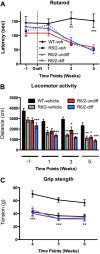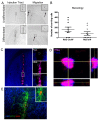Implantation of undifferentiated and pre-differentiated human neural stem cells in the R6/2 transgenic mouse model of Huntington's disease
- PMID: 22876937
- PMCID: PMC3502570
- DOI: 10.1186/1471-2202-13-97
Implantation of undifferentiated and pre-differentiated human neural stem cells in the R6/2 transgenic mouse model of Huntington's disease
Abstract
Background: Cell therapy is a potential therapeutic approach for several neurodegenetative disease, including Huntington Disease (HD). To evaluate the putative efficacy of cell therapy in HD, most studies have used excitotoxic animal models with only a few studies having been conducted in genetic animal models. Genetically modified animals should provide a more accurate representation of human HD, as they emulate the genetic basis of its etiology.
Results: In this study, we aimed to assess the therapeutic potential of a human striatal neural stem cell line (STROC05) implanted in the R6/2 transgenic mouse model of HD. As DARPP-32 GABAergic output neurons are predominately lost in HD, STROC05 cells were also pre-differentiated using purmorphamine, a hedgehog agonist, to yield a greater number of DARPP-32 cells. A bilateral injection of 4.5x105 cells of either undifferentiated or pre-differentiated DARPP-32 cells, however, did not affect outcome compared to a vehicle control injection. Both survival and neuronal differentiation remained poor with a mean of only 161 and 81 cells surviving in the undifferentiated and differentiated conditions respectively. Only a few cells expressed the neuronal marker Fox3.
Conclusions: Although the rapid brain atrophy and short life-span of the R6/2 model constitute adverse conditions to detect potentially delayed treatment effects, significant technical hurdles, such as poor cell survival and differentiation, were also sub-optimal. Further consideration of these aspects is therefore needed in more enduring transgenic HD models to provide a definite assessment of this cell line's therapeutic relevance. However, a combination of treatments is likely needed to affect outcome in transgenic models of HD.
Figures





Similar articles
-
A critical window of CAG repeat-length correlates with phenotype severity in the R6/2 mouse model of Huntington's disease.J Neurophysiol. 2012 Jan;107(2):677-91. doi: 10.1152/jn.00762.2011. Epub 2011 Nov 9. J Neurophysiol. 2012. PMID: 22072510 Free PMC article.
-
Intracerebral transplantation of neural stem cells combined with trehalose ingestion alleviates pathology in a mouse model of Huntington's disease.J Neurosci Res. 2009 Jan;87(1):26-33. doi: 10.1002/jnr.21817. J Neurosci Res. 2009. PMID: 18683244 Free PMC article.
-
Activation of NPY-Y2 receptors ameliorates disease pathology in the R6/2 mouse and PC12 cell models of Huntington's disease.Exp Neurol. 2018 Apr;302:112-128. doi: 10.1016/j.expneurol.2018.01.001. Epub 2018 Jan 6. Exp Neurol. 2018. PMID: 29309751
-
Producing striatal phenotypes for transplantation in Huntington's disease.Exp Biol Med (Maywood). 2012 Apr;237(4):343-51. doi: 10.1258/ebm.2011.011359. Epub 2012 Apr 4. Exp Biol Med (Maywood). 2012. PMID: 22490511 Review.
-
Choosing an animal model for the study of Huntington's disease.Nat Rev Neurosci. 2013 Oct;14(10):708-21. doi: 10.1038/nrn3570. Nat Rev Neurosci. 2013. PMID: 24052178 Review.
Cited by
-
Pathogenesis and potential therapeutic application of stem cells transplantation in Huntington's disease.Regen Ther. 2022 Sep 25;21:406-412. doi: 10.1016/j.reth.2022.09.001. eCollection 2022 Dec. Regen Ther. 2022. PMID: 36196447 Free PMC article. Review.
-
Development and validation of broad-spectrum magnetic particle labelling processes for cell therapy manufacturing.Stem Cell Res Ther. 2018 Sep 26;9(1):248. doi: 10.1186/s13287-018-0968-0. Stem Cell Res Ther. 2018. PMID: 30257709 Free PMC article.
-
Differentiation of pluripotent stem cells into striatal projection neurons: a pure MSN fate may not be sufficient.Front Cell Neurosci. 2014 Dec 2;8:398. doi: 10.3389/fncel.2014.00398. eCollection 2014. Front Cell Neurosci. 2014. PMID: 25520619 Free PMC article. Review.
-
Direct in vivo assessment of human stem cell graft-host neural circuits.Neuroimage. 2015 Jul 1;114:328-37. doi: 10.1016/j.neuroimage.2015.03.079. Epub 2015 Apr 25. Neuroimage. 2015. PMID: 25936696 Free PMC article.
-
ESC-Derived BDNF-Overexpressing Neural Progenitors Differentially Promote Recovery in Huntington's Disease Models by Enhanced Striatal Differentiation.Stem Cell Reports. 2016 Oct 11;7(4):693-706. doi: 10.1016/j.stemcr.2016.08.018. Epub 2016 Sep 29. Stem Cell Reports. 2016. PMID: 27693427 Free PMC article.
References
-
- Capetian P, Knoth R, Maciaczyk J, Pantazis G, Ditter M, Bokla L, Landwehrmeyer GB, Volk B, Nikkhah G. Histological findings on fetal striatal grafts in a Huntington's disease patient early after transplantation. Neuroscience. 2009;160(3):661–675. doi: 10.1016/j.neuroscience.2009.02.035. - DOI - PubMed
-
- Gray JA, Grigoryan G, Virley D, Patel S, Sinden JD, Hodges H. Conditionally immortalized, multipotential and multifunctional neural stem cell lines as an approach to clinical transplantation. Cell Transplant. 2000;9(2):153–168. - PubMed
Publication types
MeSH terms
Substances
Grants and funding
LinkOut - more resources
Full Text Sources
Other Literature Sources
Medical
Research Materials

